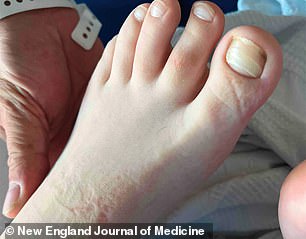Massachusetts boy, 12, goes permanently BLIND after consuming diet of plain hamburgers and donuts
A 12-year-old boy in Massachusetts has gone permanently blind because his junk food-only diet was so lacking in nutrients.
The child suffers from autism and has an extreme phobia of certain food textures, meaning he lived on a diet of plain burgers, ranch fries, donuts and juice boxes.
He started having eye problems earlier this year, with his vision becoming ‘darker’ in the morning and evening and only improving during the day.
But within six weeks he could no longer walk without leaning on his parents and was regularly bumping into doors and walls.
One night he woke up screaming that he couldn’t see.
The tween was admitted to the hospital, where doctors discovered that his diet was seriously deficient in essential nutrients that keep the optic nerves healthy.
Despite supplements and nutritional therapy, experts write in a American medical journal fear that the boy’s loss of vision is permanent.
A 12-year-old autistic boy in Massachusetts suffered severe vision loss after his limited diet of hamburgers, donuts, fries and juice boxes caused nutrient deficiencies
Doctors at Boston Children’s Hospital say the boy has avoidant/restrictive food intake disorder (ARFID), an eating disorder that affects about half of autistic children to varying degrees.
The condition, which is new but growing, causes about one in two hundred Americans to limit their variety of foods due to fear or unwanted color, taste, texture or odor.

The above image shows the horizontal ridges on the 12-year-old American boy’s toenails as they had become brittle due to multiple deficiencies of essential nutrients
Although the boy had a traumatic birth, arrived two months early and was deprived of oxygen, he had no underlying conditions other than autism and ADHD. He had speech, cognitive and motor delays.
Two days before he was admitted to the hospital, his parents said he had bags and scabs around his eyes. Sometimes they noticed he was staring at the wall instead of the TV.
The boy’s parents described him as a “picky eater” and said he avoided new foods and/or vitamins because he didn’t like the texture.
Doctors discovered that the boy suffered from optic atrophy, which causes cells in the optic nerve to waste away due to long-term damage.
They believe the vision loss was due to severe deficiencies of vitamin A, vitamin C, vitamin D, copper and zinc from the boy’s restricted diet.


Bella Mildon, an autistic preteen from Britain, went blind after her limited diet of Marmite sandwiches, chips and water left her with a vitamin A deficiency. She is pictured above before and after blindness
Vitamin A deficiency in particular is one of the most common causes of blindness in children in the US.
The nutrient is a key component in rhodopsin, a light-sensitive protein that helps produce pigments in the retina, which aid vision in areas of low light.
Vitamin D helps the eyes produce tears, which are crucial for preventing dryness and flushing away dirt. Copper and zinc both protect the cells and structure in the retina, and vitamin C helps protect the eyes from damage from ultraviolet (UV) light.
Although vitamin A deficiency affects only one in 100 Americans, experts estimate that up to 70 percent of children under the age of 11 could be deficient in vitamin D.
One in five children in the U.S. doesn’t get enough vitamin C, although serious deficiencies, called scurvy, are exceptionally rare in developed countries.
However, recent data shows that the incidence of scurvy has tripled from eight in 100,000 children in 2016 to 27 in 100,000 in 2020, leading to tooth loss, brittle hair, flaky skin, difficulty gaining weight and anemia.

Ella Witrock, a 12-year-old from Pennsylvania, developed ARFID when she was seven. She becomes severely malnourished due to an extreme fear of vomiting
The boy’s lack of nutrients also caused him to develop horizontal ridges on his toenails, which had become brittle.
The researchers noted that autistic children may be more likely to have ARFID and other problems with food because of their unique sensory challenges, which make them particularly sensitive to textures, tastes and smells.
Autistic children also tend to stick to routine, which may cause them to prefer certain foods.
The Massachusetts boy was given supplements with vitamins A, C, D and K, as well as calcium, thiamine, copper and zinc at the hospital.
The boy’s nutrient levels normalized and he started eating lettuce and cheese on his burgers after the family started behavioral therapy.
His parents added a clear supplement to his juice boxes, although he started refusing it after a few weeks.
The researchers wrote: ‘Unfortunately, the patient’s optic atrophy was severe.
‘This severe degree of vision loss cannot be reversed if it is diagnosed at such an advanced stage. If detected earlier in the disease course, reversing the nutritional deficiency may lead to some improvement in vision.”
